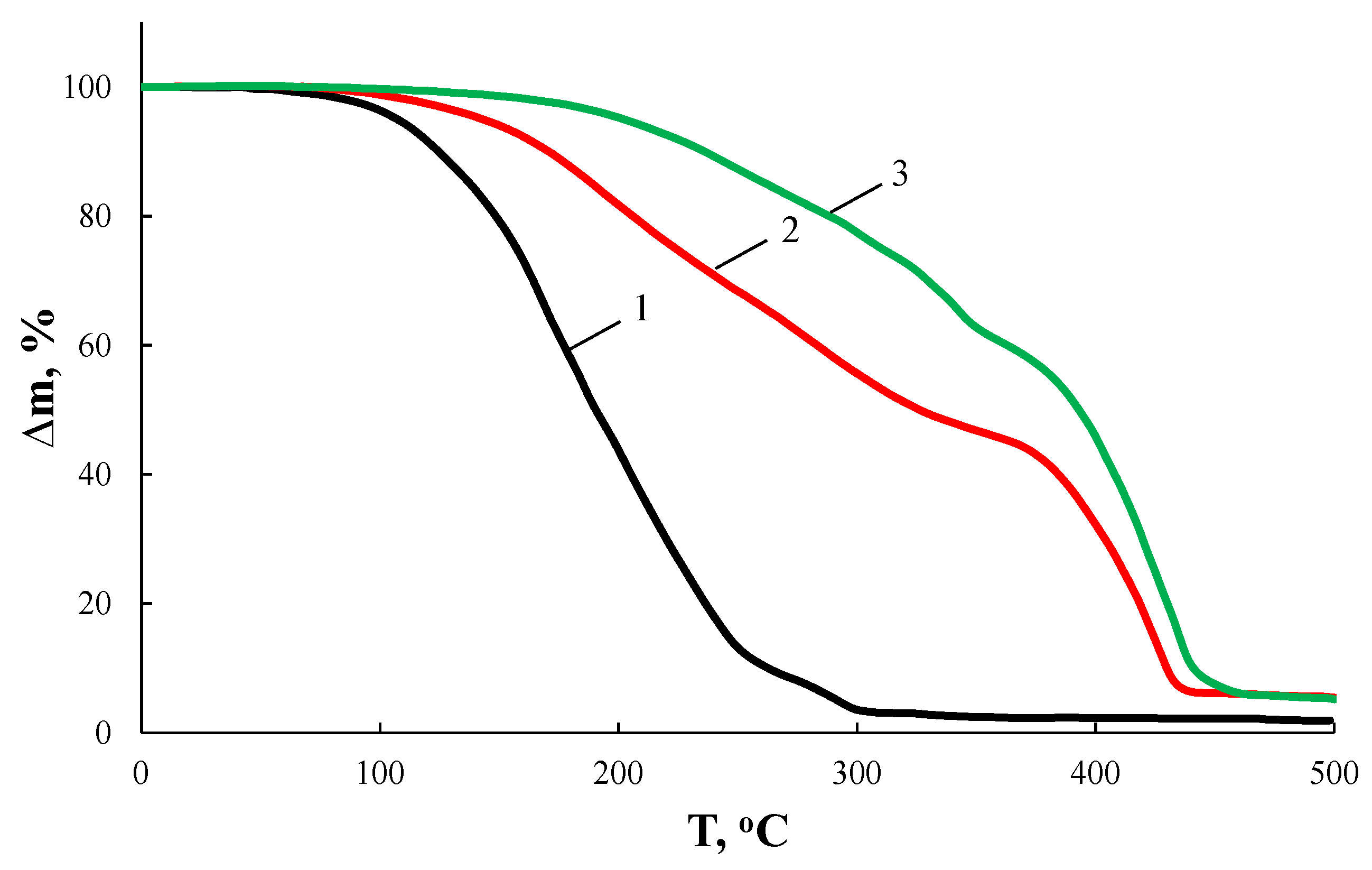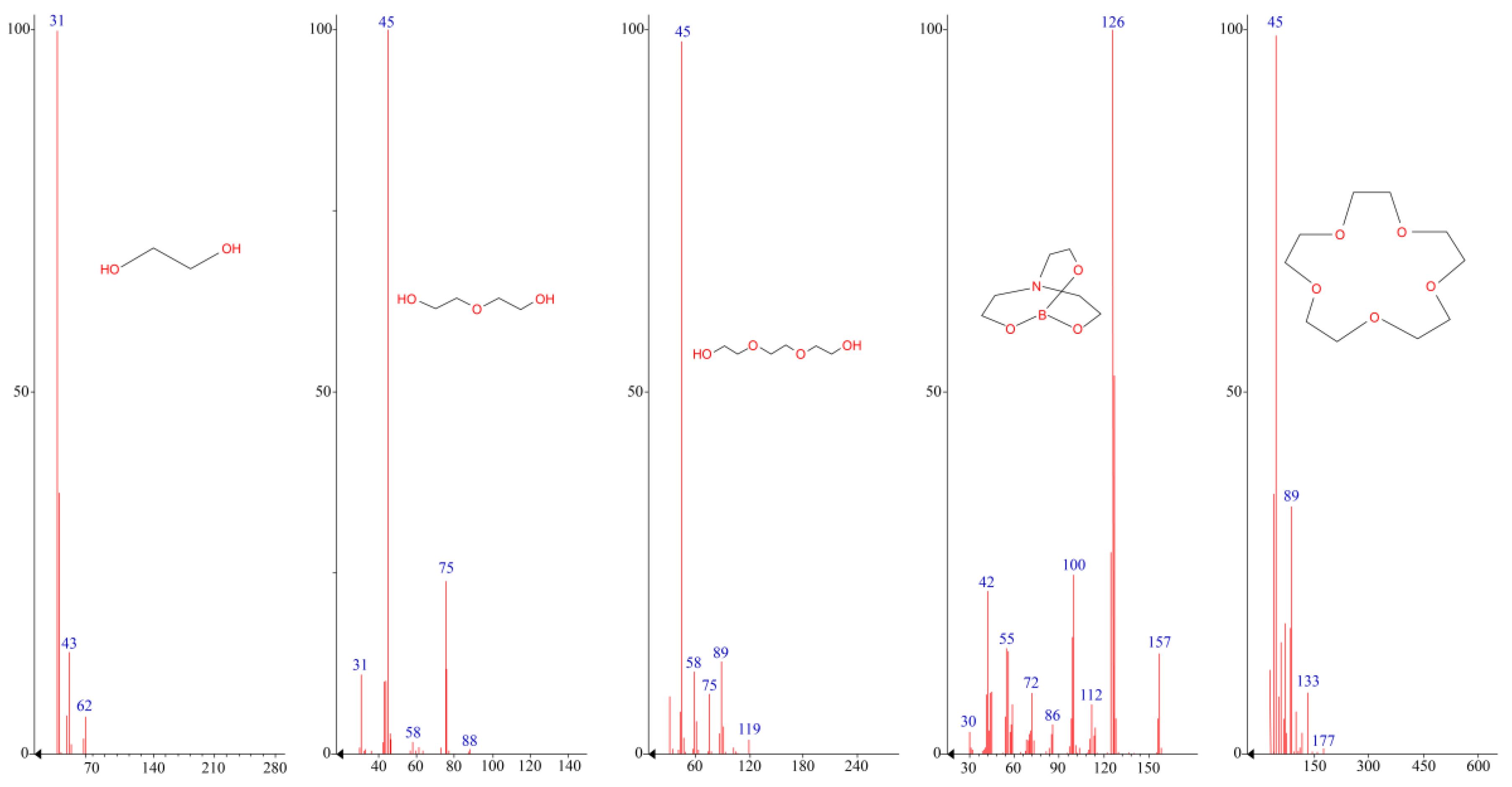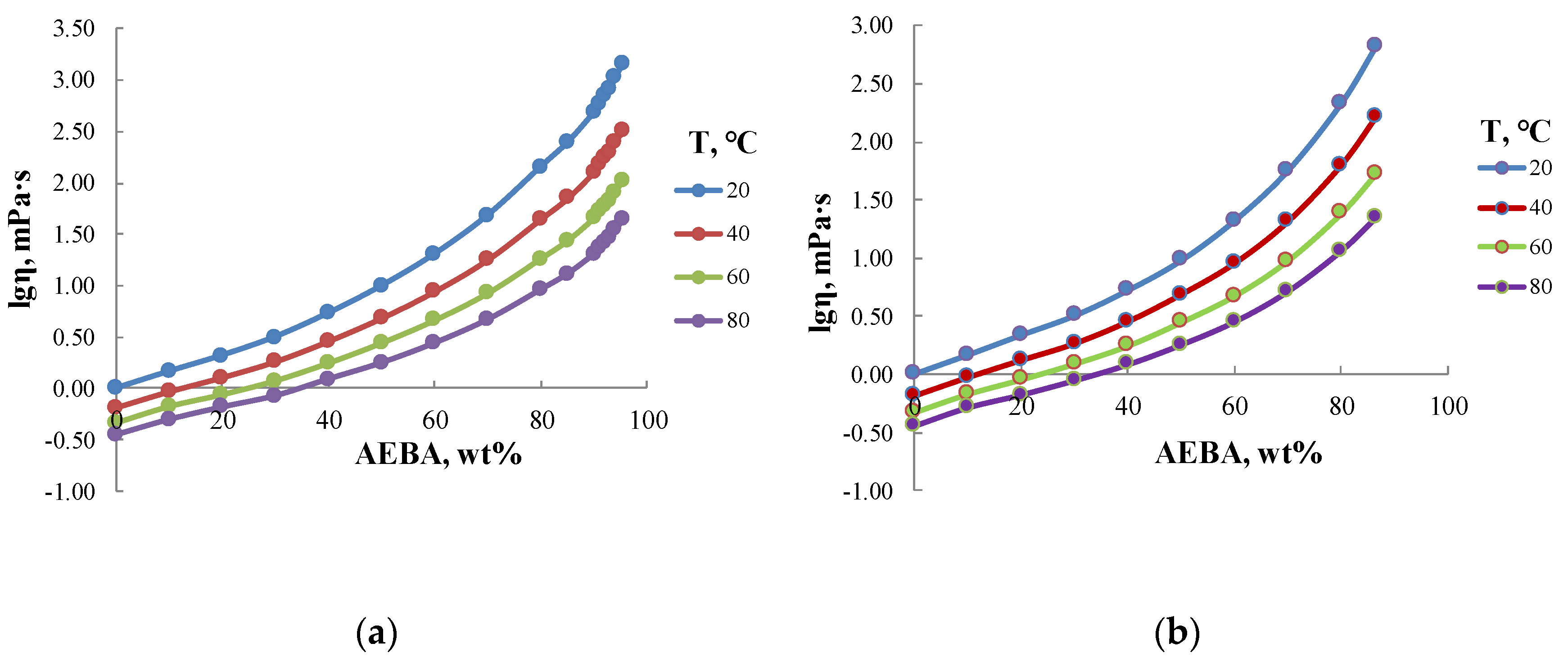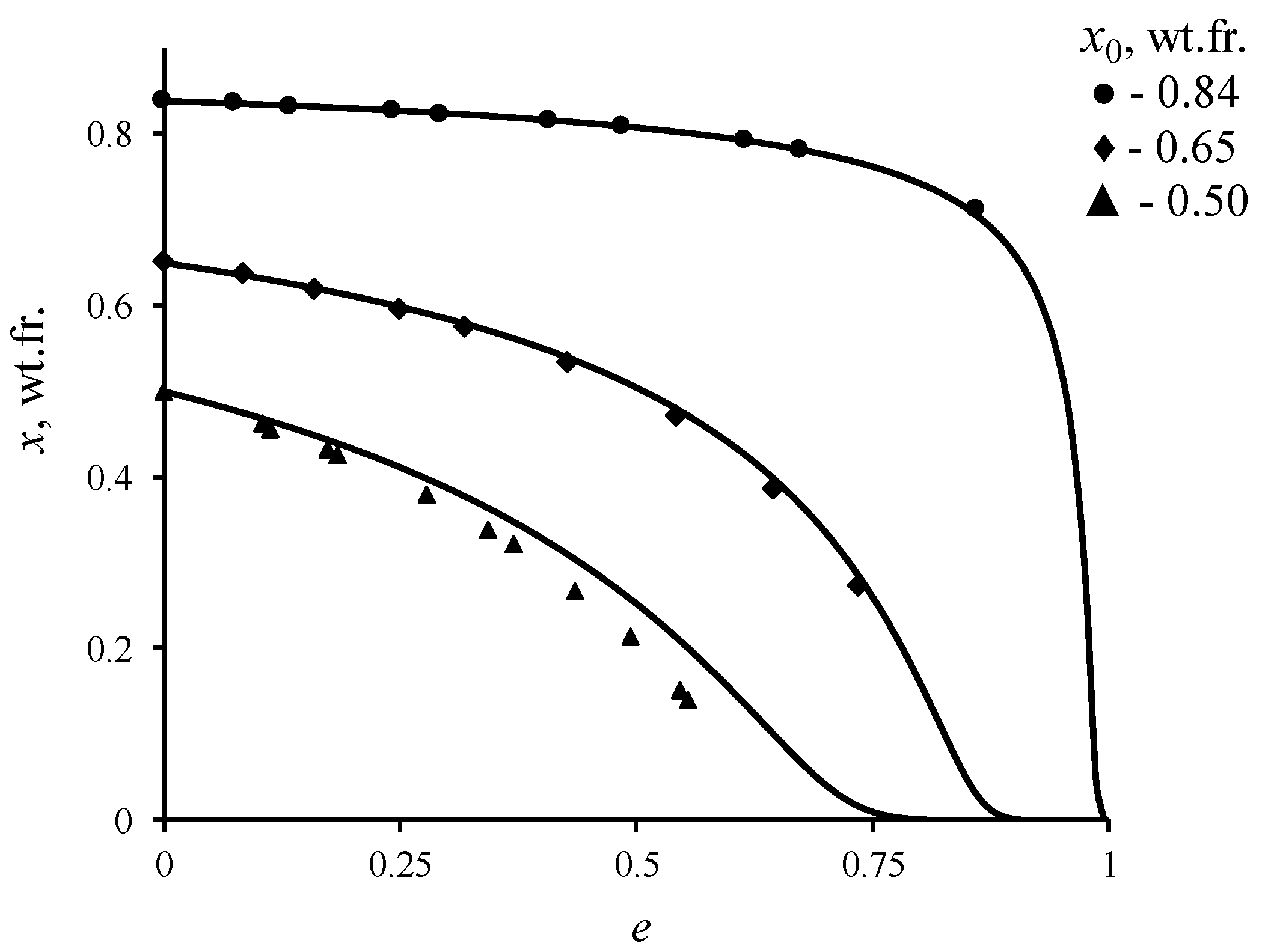Organoboron Ionic Liquids as Extractants for Distillation Process of Binary Ethanol + Water Mixtures
Abstract
1. Introduction
2. Materials and Methods
2.1. Materials
2.2. Synthesis Process
2.3. Preparation of Aqueous Solutions
2.4. Viscometry and Determination of Density
2.5. Determination of Electrical Conductivity of Solutions
2.6. Thermogravimetric Analysis (TGA) Combined with Fourier-IR and Exhaust Gas Mass-Spectroscopy
2.7. Fast Scanning Calorimetry Measurement
2.8. Phase Equilibrium Experiments
3. Results
3.1. Thermal Behavior of Aminoethers of Boric Acid
3.2. Fast Scanning Calorimetry
3.3. The Study of Aqueous Solutions of AEBA–TEG and AEBA–DEG
3.4. Vapor–Liquid Equilibrium for Ethanol–Water Mixture in the Presence of AEBA
4. Conclusions
Author Contributions
Funding
Conflicts of Interest
Abbreviations
| TEA | triethanolamine |
| MEG | monoethylene glycol |
| DEG | diethylene glycol |
| TEG | triethylene glycol |
| AEBA | aminoethers of boric acid |
| AEBA–MEG | aminoethers of boric acid based on monoethylene glycol |
| AEBA–DEG | aminoethers of boric acid based on diethylene glycol |
| AEBA–TEG | aminoethers of boric acid based on triethylene glycol |
| TGA | thermogravimetric analysis |
| L0 | initial mass of mixture |
| x0 | initial concentration of ethanol in the mixture |
| L | mass of boiling mixture |
| P | mass distillate |
| e | distillate rate |
| α12 | coefficient of relative volatility |
References
- Rogers, R.D.; Seddon, K.R. Ionic liquids. In Industrial Applications to Green Chemistry; ACS Oxford University Press: Washington, DC, USA, 2002; p. 470. [Google Scholar]
- Billeci, F.; D’Anna, F.; Feroci, M.; Cancemi, P.; Feo, S.; Forlino, A.; Tonelli, F.; Seddon, K.R.; Gunaratne, H.Q.N.; Plechkova, N.V. When Functionalization Becomes Useful: Ionic Liquids with a “Sweet” Appended Moiety Demonstrate Drastically Reduced Toxicological Effects. ACS Sustain. Chem. Eng. 2020, 8, 926–938. [Google Scholar] [CrossRef]
- Ventura, S.P.M.; Gonçalves, A.; Sintra, T.; Pereira, J.L.; Gonçalves, F.J.M.; Coutinho, J.A.P. Designing ionic liquids: The chemical structure role in the toxicity. Ecotoxicology 2012, 22, 1–12. [Google Scholar] [CrossRef] [PubMed]
- Reslan, M.; Kayser, V. Ionic liquids as biocompatible stabilizers of proteins. Biophys. Rev. 2018, 10, 781–793. [Google Scholar] [CrossRef] [PubMed]
- Wilkes, J.S.; Levinsky, J.A.; Wilson, R.A.; Hussey, C.L. Dialkylimidazolium Chloroaluminate Melts: A New Class of Room-Temperature Ionic Liquids for Electrochemistry, Spectroscopy, and Synthesis. Inorg. Chem. 1982, 21, 1263–1264. [Google Scholar] [CrossRef]
- Castner, E.W.; Margulis, C.J.; Maroncelli, M.; Wishart, J.F. Ionic Liquids:Structure and Photochemical Reactions. Annu. Rev. Phys. Chem. 2011, 62, 85–105. [Google Scholar] [CrossRef]
- Weingärtner, H. NMR studies of ionic liquids: Structure and dynamics. Curr. Opin. Colloid Interface Sci. 2013, 18, 183–189. [Google Scholar] [CrossRef]
- Li, J.; Liang, X.-Z.; Li, W.; Lu, W. Synthesis and catalytic activity of porous polymer containing ionic liquid structures. Kinet. Catal. 2016, 57, 840–846. [Google Scholar] [CrossRef]
- Gardas, R.L.; Costa, H.F.; Freire, M.G.; Carvalho, P.J.; Marrucho, I.M.; Fonseca, I.; Ferreira, A.G.M.; Coutinho, J.A.P. Densities and Derived Thermodynamic Properties of Imidazolium-, Pyridinium-, Pyrrolidinium-, and Piperidinium-Based Ionic Liquids. J. Chem. Eng. Data 2008, 53, 805–811. [Google Scholar] [CrossRef]
- Meng, Z.; Zheng, X.; Tang, K.; Liu, J.; Qin, S. Dissolution of natural polymers in ionic liquids: A rewiew. e-Polymers 2012, 12, 1–29. [Google Scholar] [CrossRef]
- Li, X.J.; Sun, Y.S.; Zhao, Q. Experimental Research on the Solubility of Cellulose in Different Ionic Liquids. Adv. Mater. Res. 2013, 690–693, 1568–1571. [Google Scholar] [CrossRef]
- Enslow, K.R.; Bell, A.T. The kinetics of Brønsted acid-catalyzed hydrolysis of hemicellulose dissolved in 1-ethyl-3-methylimidazolium chloride. RSC Adv. 2012, 2, 10028–10036. [Google Scholar] [CrossRef]
- Kunz, W.; Häckl, K. The hype with ionic liquids as solvents. Chem. Phys. Lett. 2016, 661, 6–12. [Google Scholar] [CrossRef]
- Earle, M.J.; Seddon, K.R. Ionic liquids. Green solvents for the future. Pure Appl. Chem. 2000, 72, 1391–1398. [Google Scholar] [CrossRef]
- Angueira, E.J.; White, M.G. Super acidic ionic liquids for arene carbonylation derived from dialkylimidazolium chlorides and MCl3 (M = Al, Ga, or In). J. Mol. Catal. A Chem. 2007, 227, 164–170. [Google Scholar] [CrossRef]
- Park, D.-W.; Mun, N.-Y.; Kim, K.-H.; Kim, I.; Park, S.-W. Addition of carbon dioxide to allylglycidyl ether using ionic liquids catalysts. Catal. Today 2006, 115, 130–133. [Google Scholar] [CrossRef]
- Vilá, J.; Gines, P.; Rilo, E.; Cabeza, O.; Varela, L.M. Great Increase of the Electric Conductivity of Ionic Liquids in Aqueous Solutions. Fluid Phase Equilibria 2006, 247, 32–39. [Google Scholar] [CrossRef]
- Gao, T.; Li, X.; Wang, X.; Hu, J.; Han, F.; Fan, X.; Suo, L.; Pearse, A.J.; Lee, S.B.; Rubloff, G.; et al. A Rechargeable Al/S Battery with an Ionic-Liquid Electrolyte. Angew. Chem. Int. Ed. 2016, 55, 9898–9901. [Google Scholar] [CrossRef]
- Li, S.; Zhu, M.; Feng, G. The effects of dication symmetry on ionic liquid electrolytes in supercapacitors. J. Phys. Condens. Matter 2016, 28, 464005. [Google Scholar] [CrossRef]
- Lin, Z.; Barbara, D.; Taberna, P.-L.; Van Aken, K.L.; Anasori, B.; Gogotsi, Y.; Simon, P. Capacitance of Ti3C2Tx MXene in ionic liquid electrolyte. J. Power Sources 2016, 326, 575–579. [Google Scholar] [CrossRef]
- Chen, Y.; Cao, Y.; Lu, X.; Zhao, C.; Yan, C.; Mu, T. Water sorption in protic ionic liquids: Correlation between hygroscopicity and polarity. New J. Chem. 2013, 37, 1959–1967. [Google Scholar] [CrossRef]
- Krannich, M.; Heym, F.; Jess, A. Continuous Gas Dehydration Using the Hygroscopic Ionic Liquid [EMIM] [MeSO3] as a Promising Alternative Absorbent. Chem. Eng. Technol. 2016, 39, 343–353. [Google Scholar] [CrossRef]
- Navarro, P.; Ovejero-Pérez, A.; Ayuso, M.; Delgado-Mellado, N.; Larriba, M.; García, J.; Rodríguez, F. Rodríguez. Cyclohexane/cyclohexene separation by extractive distillation with cyano-based ionic liquids. J. Mol. Liq. 2019, 289, 111120. [Google Scholar] [CrossRef]
- Larriba, M.; Navarro, P.; Delgado-Mellado, N.; Stanisci, V.; Garcia, J.; Rodríguez, F.; García, J. Separation of aromatics from n-alkanes using tricyanomethanide-based ionic liquids: Liquid-liquid extraction, vapor-liquid separation, and thermophysical characterization. J. Mol. Liq. 2016, 223, 880–889. [Google Scholar] [CrossRef]
- Meindersma, G.W.; Quijada-Maldonado, E.; Aelmans, T.A.M.; Hernandez, J.P.G.; De Haan, A.B. Ionic Liquids in Extractive Distillation of Ethanol/Water: From Laboratory to Pilot Plant. Ion. Liq. Sci. Appl. ACS Symp. Ser. 2012, 1117, 239–257. [Google Scholar] [CrossRef]
- Pereiro, A.B.; Rodríguez, A. A study on the liquid–liquid equilibria of 1-alkyl-3-methylimidazolium hexafluorophosphate with ethanol and alkanes. Fluid Phase Equilibria 2008, 270, 23–29. [Google Scholar] [CrossRef]
- Meindersma, W.; Quijada-Maldonado, E.; Jongmans, M.T.G.; Hernandez, J.P.G.; Schuur, B.; De Haan, A.B. Extractive distillation with ionic liquids: Pilot plant experiments and conceptual process design. In Ionic Liquids for Better Separation Processes; Springer: Berlin/Heidelberg, Germany, 2016; pp. 11–38. [Google Scholar] [CrossRef]
- Quijada-Maldonado, E.; Meidersma, W.G.; De Haan, A.B. Mass Transfer in Extractive Distillation when Using Ionic Liquids as Solvents. In Heat and Mass Transfer—Advances in Modelling and Experimental Study for Industrial Applications; BoD–Books on Demand: Norderstedt, Germany, 2018; pp. 107–123. [Google Scholar] [CrossRef]
- González, E.J.; Navarro, P.; Larriba, M.; Garcia, J.; Rodríguez, F.; González, E.J.; Garcia, J. Use of selective ionic liquids and ionic liquid/salt mixtures as entrainer in a (vapor + liquid) system to separate n-heptane from toluene. J. Chem. Thermodyn. 2015, 91, 156–164. [Google Scholar] [CrossRef]
- Davletbaeva, I.M.; Emelina, O.Y.; Davletbaev, R.S.; Grebennikova, E.S.; Petukhov, A.N.; Akhmetshina, A.I.; Loskutov, V.V.; Vorotyntsev, I.V.; Sazanova, T.S. Synthesis and properties of novel polyurethanes based on amino ethers of boric acid for gas separation membranes. RSC Adv. 2015, 5, 65674–65683. [Google Scholar] [CrossRef]
- Davletbaeva, I.M.; Nurgaliyeva, G.R.; Akhmetshina, A.I.; Davletbaev, R.S.; Atlaskin, A.A.; Sazanova, T.S.; Efimov, S.V.; Klochkov, V.V.; Vorotyntsev, I.V. Porous polyurethanes based on hyperbranched amino ethers of boric acid. RSC Adv. 2016, 6, 111109–111119. [Google Scholar] [CrossRef]
- Davletbaeva, I.M.; Dulmaev, S.E.; Sazonov, O.O.; Klinov, A.V.; Davletbaev, R.S.; Gumerov, A.M. Water vapour permeable polyurethane films based on the hyperbranched aminoethers of boric acid. RSC Adv. 2019, 9, 23535–23544. [Google Scholar] [CrossRef]
- Mathot, V.; Pyda, M.; Pijpers, T.; Poel, G.V.; Van De Kerkhof, E.; Van Herwaarden, S.; Van Herwaarden, F.; Leenaers, A. The Flash DSC 1, a power compensation twin-type, chip-based fast scanning calorimeter (FSC): First findings on polymers. Thermochim. Acta 2011, 522, 36–45. [Google Scholar] [CrossRef]
- Iervolino, E.; Van Herwaarden, A.; Van Herwaarden, F.; Van De Kerkhof, E.; Van Grinsven, P.; Leenaers, A.; Mathot, V.; Sarro, P. Temperature calibration and electrical characterization of the differential scanning calorimeter chip UFS1 for the Mettler-Toledo Flash DSC. Thermochim. Acta 2011, 522, 53–59. [Google Scholar] [CrossRef]
- Zhang, Y.; Xu, X.; Yang, H.; Gao, J.; Xu, D.; Zhang, L.; Wang, Y. Separation of azeotropic mixture isopropyl alcohol + ethyl acetate by extractive distillation: Vapor-liquid equilibrium measurements and interaction exploration. Fluid Phase Equilibria 2020, 507, 112428. [Google Scholar] [CrossRef]
- Zhang, Y.; Wang, Z.; Xu, X.; Gao, J.; Xu, D.; Zhang, L.; Wang, Y. Entrainers selection and vapour-liquid equilibrium measurements for separating azeotropic mixtures (ethanol + n-hexane/cyclohexane) by extractive distillation. J. Chem. Thermodyn. 2020, 144, 106070. [Google Scholar] [CrossRef]
- Gmehling, J.; Kleiber, M.; Kolbe, B.; Rarey, J. Chemical Thermodynamics for Process Simulation; WILEY-VCH: Weinheim, Germany, 2019; p. 808. [Google Scholar]
- Nazet, A.; Sokolov, S.; Sonnleitner, T.; Makino, T.; Kanakubo, M.; Buchner, R. Densities, Viscosities, and Conductivities of the Imidazolium Ionic Liquids [Emim] [Ac], [Emim] [FAP], [Bmim] [BETI], [Bmim] [FSI], [Hmim] [TFSI], and [Omim] [TFSI]. J. Chem. Eng. Data 2015, 60, 2400–2411. [Google Scholar] [CrossRef]
- Zhuravlev, O.E.; Presnyakov, I.A.; Voronchikhina, L.I. Synthesis and physicochemical properties of N-decylpyridinium salts with inorganic anions. Russ. J. Gen. Chem. 2016, 86, 2042–2046. [Google Scholar] [CrossRef]
- Liu, W.; Cheng, L.; Zhang, Y.; Wang, H.; Yu, M. The physical properties of aqueous solution of room-temperature ionic liquids based on imidazolium: Database and evaluation. J. Mol. Liq. 2008, 140, 68–72. [Google Scholar] [CrossRef]
- Reid, R.C.; Sherwood, T.K.; Street, R.E. The Properties of Gases and Liquids, 3rd ed.; McGraw-Hill Book Comp.: New York, NY, USA, 1977; p. 688. [Google Scholar]
- Kurihara, K.; Minoura, T.; Takeda, K.; Kojima, K. Isothermal Vapor-Liquid Equilibria for Methanol + Ethanol + Water, Methanol + Water, and Ethanol + Water. J. Chem. Eng. Data 1995, 40, 679–684. [Google Scholar] [CrossRef]
- Schmidt, K.A.G.; Maham, Y.; Mather, A.E. Mather. Use of the NRTL equation for simultaneous correlation of vapour-liquid equilibria and excess enthalpy. J. Therm. Anal. Calorim. 2007, 89, 61–72. [Google Scholar] [CrossRef]
- Pereiro, A.B.; Araújo, J.M.M.; Esperança, J.M.S.S.; Marrucho, I.M.; Rebelo, L.P.N. Ionic liquids in separations of azeotropic systems—A review. J. Chem. Thermodyn. 2012, 46, 2–28. [Google Scholar] [CrossRef]
- Ge, Y.; Zhang, L.; Yuan, X.; Geng, W.; Ji, J. Selection of ionic liquids as entrainers for separation of (water + ethanol). J. Chem. Thermodyn. 2008, 40, 1248–1252. [Google Scholar] [CrossRef]
- Zhao, J.; Dong, C.-C.; Li, C.-X.; Meng, H.; Wang, Z.-H. Isobaric vapor–liquid equilibria for ethanol–water system containing different ionic liquids at atmospheric pressure. Fluid Phase Equilibria 2006, 242, 147–153. [Google Scholar] [CrossRef]
- Zhang, L.; Ge, Y.; Ji, D.; Ji, J. Experimental Measurement and Modeling of Vapor-Liquid Equilibrium for Ternary Systems Containing Ionic Liquids: A Case Study for the System Water + Ethanol + 1-Hexyl-3-methylimidazolium Chloride. J. Chem. Eng. Data 2009, 54, 2322–2329. [Google Scholar] [CrossRef]
- Geng, W.; Zhang, L.; Deng, D.; Ge, Y.; Ji, J. Experimental Measurement and Modeling of Vapor-Liquid Equilibrium for the Ternary System Water + Ethanol + 1-Butyl-3-methylimidazolium Chloride. J. Chem. Eng. Data 2010, 55, 1679–1683. [Google Scholar] [CrossRef]








| Sample | TΔm 5%, °C | TΔm 10%, °C | TΔm 50%, °C |
|---|---|---|---|
| AEBA–MEG | <100 | 123 | 190 |
| AEBA–DEG | 149 | 171 | 327 |
| AEBA–TEG | 175 | 233 | 392 |
| Density, g/cm3 | Temperature, °C | Temperature, °C | |||||||
|---|---|---|---|---|---|---|---|---|---|
| 20 | 40 | 60 | 80 | 100 | 20 | 40 | 60 | 80 | |
| AEBA, wt% | AEBA–TEG | AEBA–DEG | |||||||
| 0 | 0.998 | 0.992 | 0.983 | 0.971 | - | 0.998 | 0.992 | 0.983 | 0.971 |
| 10 | 1.020 | 1.012 | 1.001 | 0.99 | - | 1.022 | 1.014 | 1.005 | 0.992 |
| 20 | 1.043 | 1.033 | 1.022 | 1.009 | - | 1.048 | 1.032 | 1.028 | 1.015 |
| 30 | 1.065 | 1.054 | 1.042 | 1.029 | - | 1.073 | 1.062 | 1.05 | 1.036 |
| 40 | 1.091 | 1.079 | 1.065 | 1.050 | 1.034 | 1.100 | 1.088 | 1.075 | 1.059 |
| 50 | 1.115 | 1.101 | 1.087 | 1.071 | 1.054 | 1.127 | 1.113 | 1.099 | 1.083 |
| 60 | 1.137 | 1.122 | 1.107 | 1.091 | 1.074 | 1.151 | 1.136 | 1.122 | 1.106 |
| 70 | 1.157 | 1.142 | 1.126 | 1.110 | 1.093 | 1.174 | 1.159 | 1.144 | 1.128 |
| 80 | 1.175 | 1.160 | 1.144 | 1.127 | 1.110 | 1.194 | 1.180 | 1.165 | 1.148 |
| 85 | 1.181 | 1.166 | 1.149 | 1.133 | 1.116 | - | - | - | - |
| 86.5 | - | - | - | - | - | 1.206 | 1.191 | 1.175 | 1.158 |
| 90 | 1.187 | 1.171 | 1.155 | 1.139 | 1.122 | - | - | - | - |
| 91 | 1.189 | 1.172 | 1.156 | 1.140 | 1.123 | - | - | - | - |
| 92 | 1.190 | 1.173 | 1.157 | 1.140 | 1.123 | - | - | - | - |
| 93 | 1.190 | 1.174 | 1.157 | 1.140 | 1.123 | - | - | - | - |
| 94 | 1.191 | 1.175 | 1.158 | 1.141 | 1.125 | - | - | - | - |
| 95.4 | 1.191 | 1.174 | 1.157 | 1.141 | 1.124 | - | - | - | - |
| wAEBA | Interval of Liquid Phase Compositions Based on Ethanol x | α12(AEBA–TEG) | α12(AEBA–DEG) |
|---|---|---|---|
| 0.25 | 0.84–0.87 | 1.95 | 1.65 |
| 0.30 | 0.82–0.85 | 2.21 | 1.80 |
| 0.40 | 0.78–0.86 | 2.89 | 2.05 |
| 0.50 | 0.64–0.81 | 3.37 | 2.50 |
| 0.60 | 0.53–0.83 | 4,17 | 4.50 |
| 0.70 | 0.37–0.77 | 4.50 | 4.95 |
| 0.75 | 0.59–0.73 | 5.04 | 5.68 |
© 2020 by the authors. Licensee MDPI, Basel, Switzerland. This article is an open access article distributed under the terms and conditions of the Creative Commons Attribution (CC BY) license (http://creativecommons.org/licenses/by/4.0/).
Share and Cite
Davletbaeva, I.M.; Klinov, A.V.; Khairullina, A.R.; Malygin, A.V.; Dulmaev, S.E.; Davletbaeva, A.R.; Mukhametzyanov, T.A. Organoboron Ionic Liquids as Extractants for Distillation Process of Binary Ethanol + Water Mixtures. Processes 2020, 8, 628. https://doi.org/10.3390/pr8050628
Davletbaeva IM, Klinov AV, Khairullina AR, Malygin AV, Dulmaev SE, Davletbaeva AR, Mukhametzyanov TA. Organoboron Ionic Liquids as Extractants for Distillation Process of Binary Ethanol + Water Mixtures. Processes. 2020; 8(5):628. https://doi.org/10.3390/pr8050628
Chicago/Turabian StyleDavletbaeva, Ilsiya M., Alexander V. Klinov, Alina R. Khairullina, Alexander V. Malygin, Sergey E. Dulmaev, Alisa R. Davletbaeva, and Timur A. Mukhametzyanov. 2020. "Organoboron Ionic Liquids as Extractants for Distillation Process of Binary Ethanol + Water Mixtures" Processes 8, no. 5: 628. https://doi.org/10.3390/pr8050628
APA StyleDavletbaeva, I. M., Klinov, A. V., Khairullina, A. R., Malygin, A. V., Dulmaev, S. E., Davletbaeva, A. R., & Mukhametzyanov, T. A. (2020). Organoboron Ionic Liquids as Extractants for Distillation Process of Binary Ethanol + Water Mixtures. Processes, 8(5), 628. https://doi.org/10.3390/pr8050628






